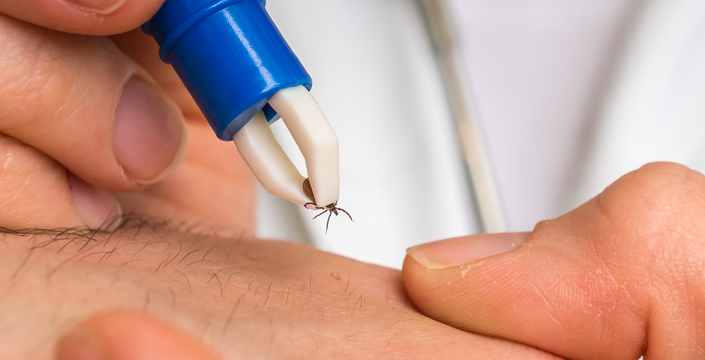
With September comes change. Kids are back to school, cool, crisp weather has settled in, and the changing colours of autumn are starting to show; perfect for outdoor class trips and leisurely hikes. One thing that hasn’t changed is that ticks are in our area and remain active throughout fall; in fact, ticks can remain active at any time of year when the temperature is above freezing. So as you’re getting outside to admire the beauty of autumn, keep these facts about ticks and Lyme disease in mind.
1. Ticks do not run, jump, or move very quickly so you won’t find them falling from trees or jumping from bushes. Ticks usually hang around on thigh-high vegetation in wooded, brushy areas and are transferred to people when they are brushed up against. The tick will latch to your skin or your clothes and then search out an area where it can plug-in. While ticks, theoretically, can be found just about anywhere, groomed outdoor areas like sports fields or playgrounds are not considered to be good habitat for ticks.
2. Blacklegged ticks can carry the bacteria that causes Lyme disease, Borrelia burgdorferi, but not all blacklegged ticks are infected. An infected blacklegged tick must be actively feeding for at least 24 hours to spread the bacteria. A tick that is feeding will become swollen and oversized, and may look a pale shade of green or yellow.
5. Ticks can attach to any area of your body and be as small as a poppy seed. To make it easier to see ticks, wear light-coloured pants and a long-sleeved shirt while outdoors, and also use an insect repellent with DEET or Icaridin. Perform daily full-body tick checks on yourself, your children, and your pets after coming indoors. If after being outside, say on a hike, you find a tick on your dog, check your skin more thoroughly - it may be a clue that you have walked through a tick habitat.
3. The classic symptom of Lyme disease is an expanding ‘bulls-eye’ red rash but it doesn’t appear in every case. Other symptoms of Lyme disease include a fever, headache, muscle and joint pain, and fatigue. These symptoms commonly start between three days and one month after being bitten by an infected blacklegged tick. If you’ve been bitten by a tick and are feeling off or are concerned, contact your healthcare provider.
4. You can submit ticks to Public Health for identification. Click here to download the form. Bring the completed form and the dead tick in a tightly sealed, transparent container into a Public Health office.
For more information about ticks and Lyme disease, click here.
